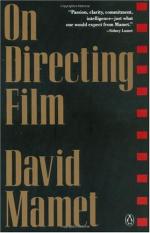
|
| Name: _________________________ | Period: ___________________ |
This test consists of 5 multiple choice questions, 5 short answer questions, and 10 short essay questions.
Multiple Choice Questions
1. Who told Alice it didn't matter which road she took, as cited by Mamet in Chapter 2?
(a) The Mad Hatter.
(b) The Cheshire Cat.
(c) The Caterpillar.
(d) The Rabbit.
2. What is the term which refers to the protagonist's immediate goal?
(a) Motivation.
(b) Objective.
(c) Obstacle.
(d) Superobjective.
3. According to Mamet in Chapter 3, "You tax the audience every time you don't move on to _______ of the progression as quickly as possible."
(a) The action.
(b) The next essential step.
(c) The essential truth.
(d) The MacGuffin.
4. Sometimes, Mamet says in Chapter 3, the piece (film) will do what?
(a) Create impediments.
(b) Create roadblocks.
(c) Work with you.
(d) Fight back against you.
5. Counterculture architecture was based on designing buildings based on what?
(a) The weather.
(b) The setting.
(c) How the architect felt.
(d) The natural surroundings.
Short Answer Questions
1. According to Mamet in Chapter 3, he challenges the way people talk about any performance artist and the way they talk about whom?
2. Who wrote The Uses of Enchantment?
3. Who wrote Memories, Dream, Reflections?
4. Chair makers, until the turn of the century, made their chairs without what?
5. What is the rule which Mamet says means "Keep it simple, stupid"?
Short Essay Questions
1. What did Mamet write in Chapter 3 regarding film with political agendas?
2. What are the different approaches Mamet discussed as methods of storytelling in film, in Chapter 1?
3. What are ways that directors attempt to keep the audience's attention when the design of a film fails?
4. What did Mamet write in the Preface regarding the blind author who decided to become a screenwriter?
5. What did Mamet think of the steadicam?
6. What did Mamet write of producers in Chapter 2?
7. How did Mamet describe Eisenstein's theory of montage?
8. What writers and filmmakers did Mamet refer to in the Preface and Chapter 1 regarding screenwriting and film direction?
9. What did Mamet indicate is the point of view of the performance artist, in Chapter 3?
10. What does Mamet say regarding the juxtaposition of uninflected images in Chapter 3?
|
This section contains 873 words (approx. 3 pages at 300 words per page) |

|




